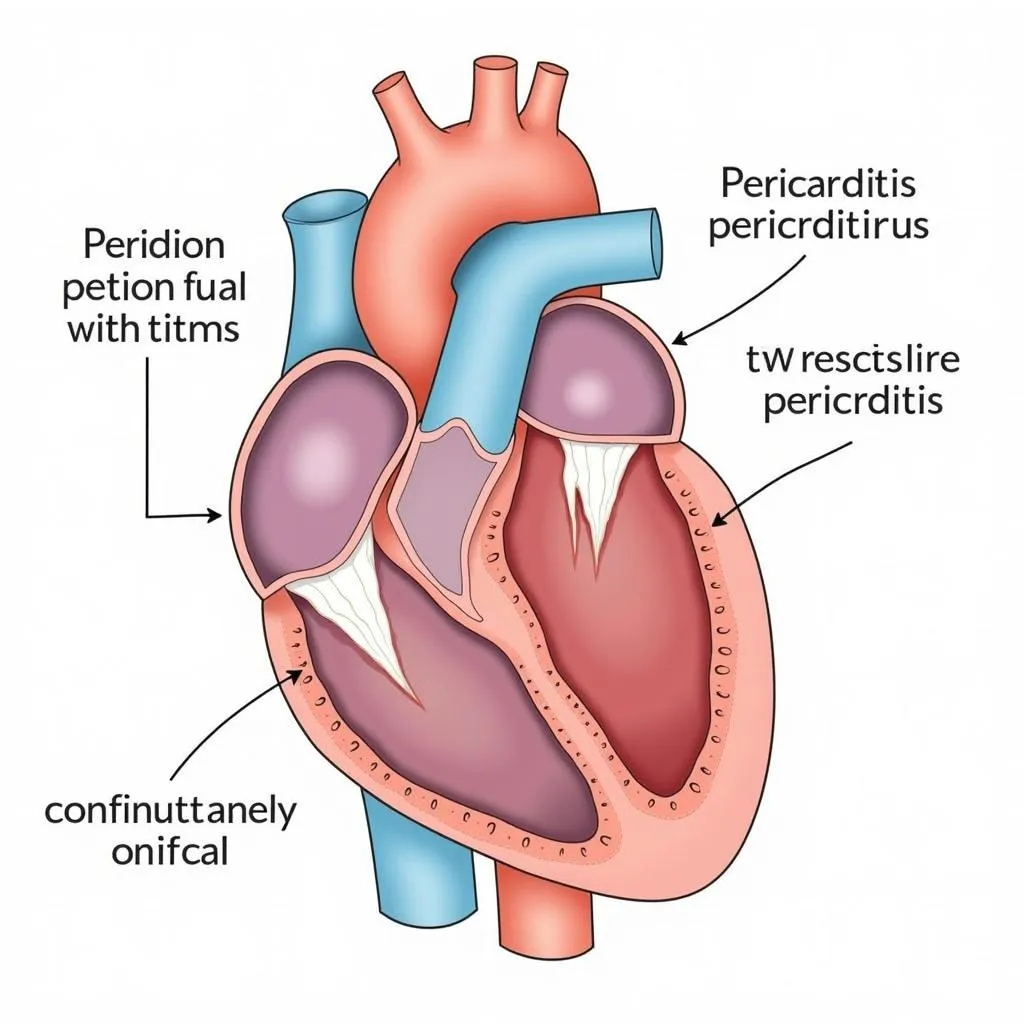Pericardial disease refers to a range of conditions affecting the pericardium, the double-layered sac surrounding the heart. This sac, filled with a small amount of fluid, acts as a protective cushion, allowing the heart to beat efficiently. When the pericardium becomes inflamed or filled with excess fluid, it can disrupt the heart’s normal function, leading to pericardial disease. In the ASEAN region, with its diverse population and environmental factors, understanding the complexities of pericardial disease is crucial for effective diagnosis and management.
Delving into the Types and Causes of Pericardial Disease
Pericardial disease encompasses various conditions, each with unique characteristics:
- Pericarditis: Inflammation of the pericardium, often causing chest pain that worsens with breathing or lying down.
- Pericardial effusion: Buildup of excess fluid between the layers of the pericardium, potentially leading to heart compression.
- Cardiac tamponade: A life-threatening condition where significant fluid accumulation puts pressure on the heart, restricting its ability to pump blood effectively.
- Constrictive pericarditis: Thickening and scarring of the pericardium, constricting the heart and impairing its filling capacity.
Several factors can contribute to the development of pericardial disease:
- Infections: Viral, bacterial, fungal, or parasitic infections are common triggers of pericarditis.
- Autoimmune diseases: Conditions like lupus, rheumatoid arthritis, and scleroderma can cause the body’s immune system to attack the pericardium.
- Heart attack: Pericarditis can occur during or after a heart attack, often as a reaction to heart tissue damage.
- Injury: Chest trauma, surgery, or radiation therapy can lead to pericardial inflammation or fluid buildup.
- Kidney failure: Inadequate waste removal in kidney failure can result in pericardial effusion.
- Cancer: Certain cancers, particularly lung cancer and breast cancer, can spread to the pericardium.
- Medications: Some medications, such as certain antibiotics and anti-seizure drugs, may have pericarditis as a side effect.
 Illustration of Pericardial Disease
Illustration of Pericardial Disease
Recognizing the Symptoms of Pericardial Disease
The symptoms of pericardial disease can vary widely depending on the specific condition and its severity. However, some common signs and symptoms include:
- Chest pain: Typically sharp and stabbing, worsening with deep breaths, coughing, or lying down, and often relieved by sitting up and leaning forward.
- Shortness of breath: Difficulty breathing, especially when lying down, due to pressure on the lungs from excess pericardial fluid.
- Heart palpitations: A feeling of fluttering, pounding, or irregular heartbeat, often caused by the heart’s effort to compensate for decreased pumping efficiency.
- Swelling in the legs, ankles, and feet: Fluid retention due to the heart’s inability to pump effectively can lead to edema in the lower extremities.
- Fatigue: Persistent tiredness and weakness, a general symptom of the body’s struggle to function with a compromised heart.
- Fever: Often a sign of inflammation or infection, especially in cases of pericarditis.
- Cough: A dry, persistent cough may occur due to irritation of the lungs from fluid buildup or inflammation.
Diagnosing and Treating Pericardial Disease in the ASEAN Context
Diagnosing pericardial disease requires a comprehensive evaluation, including:
- Medical history and physical exam: A thorough assessment of the patient’s symptoms, medical history, and family history of heart conditions is crucial.
- Electrocardiogram (ECG): This test records the heart’s electrical activity and can detect abnormalities in heart rhythm and pericardial inflammation.
- Echocardiogram: Using sound waves, an echocardiogram creates images of the heart, revealing pericardial fluid accumulation, pericardial thickening, or heart function impairment.
- Chest X-ray: A chest X-ray can show an enlarged heart silhouette if significant fluid has accumulated in the pericardium.
- Computed tomography (CT) scan: A CT scan provides detailed images of the heart and surrounding structures, aiding in the diagnosis of pericarditis, pericardial effusion, or other abnormalities.
- Magnetic resonance imaging (MRI): Similar to a CT scan, an MRI uses a magnetic field and radio waves to create detailed images of the heart, helping to diagnose pericardial disease.
- Pericardiocentesis: In cases of significant fluid buildup, a needle is inserted into the pericardial space to drain the excess fluid, relieving pressure on the heart.
Treatment for pericardial disease depends on the underlying cause and the severity of the condition:
- Medications:
- Anti-inflammatory drugs: Nonsteroidal anti-inflammatory drugs (NSAIDs) like ibuprofen or naproxen can reduce inflammation and pain associated with pericarditis.
- Colchicine: This medication can help reduce inflammation and prevent recurrent episodes of pericarditis.
- Corticosteroids: In severe cases, corticosteroids like prednisone may be prescribed to suppress inflammation.
- Pericardiocentesis: As mentioned earlier, this procedure drains excess fluid from the pericardium, relieving pressure on the heart and improving its function.
- Pericardiectomy: In cases of constrictive pericarditis, surgical removal of the pericardium may be necessary to relieve constriction and improve heart function.
 Pericardiocentesis Procedure
Pericardiocentesis Procedure
Living with Pericardial Disease in ASEAN
Living with pericardial disease requires ongoing management and lifestyle modifications:
- Regular follow-up appointments: Regular checkups with a cardiologist are crucial to monitor the condition, adjust medications if needed, and address any concerns.
- Healthy lifestyle:
- Heart-healthy diet: A balanced diet low in sodium, saturated fats, and cholesterol can help manage blood pressure and improve heart health.
- Regular exercise: Engaging in regular physical activity, as tolerated, can strengthen the heart and improve overall cardiovascular health.
- Stress management: Techniques like deep breathing exercises, meditation, or yoga can help reduce stress, which can exacerbate heart conditions.
- Smoking cessation: Smoking damages blood vessels and increases the risk of heart disease, making quitting essential.
- Vaccinations: Staying up-to-date on vaccinations, especially for influenza and pneumonia, can help prevent infections that could trigger pericarditis.
ASEAN Media: Your Trusted Source for Health Information
Understanding pericardial disease is crucial for early detection, effective management, and improved outcomes. By raising awareness, promoting timely diagnosis, and supporting individuals living with this condition, we can collectively strive for a healthier ASEAN community. Remember, if you have any concerns about your heart health, seek immediate medical attention.
Need Assistance? Contact Us!
Phone: 0369020373
Email: aseanmediadirectory@gmail.com
Address: Thôn Ngọc Liễn, Hiệp Hòa, Bắc Giang, Việt Nam
Our dedicated customer support team is available 24/7 to assist you.


